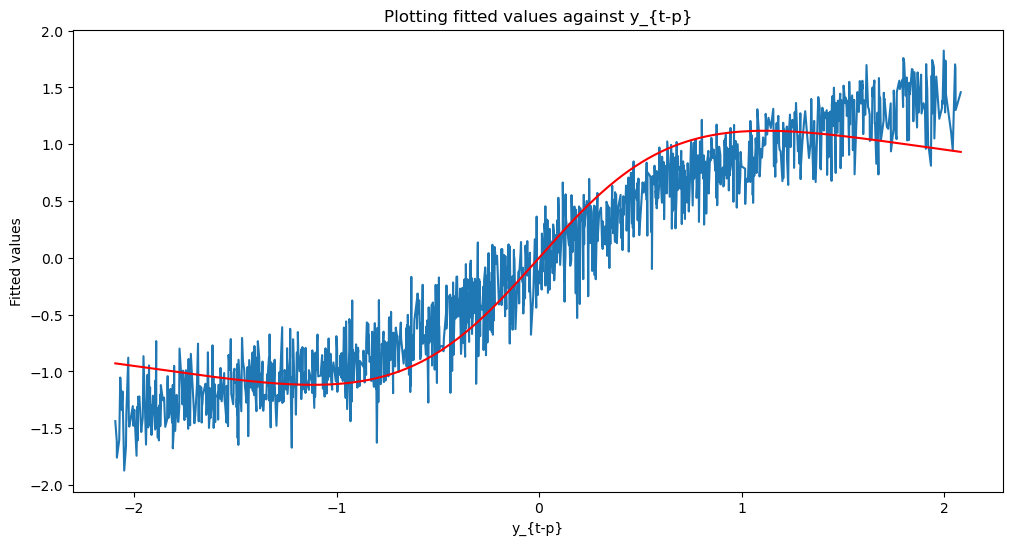import numpy as np
import pandas as pd
import matplotlib.pyplot as plt
import statsmodels.api as sm
import torch
import torch.nn as nn
import torch.optim as optim
from statsmodels.tsa.arima.model import ARIMA
from statsmodels.tsa.ar_model import AutoRegWe fit the NonLinear AR(1) model to a simulated dataset generated using the following equation:
where .
n = 450
rng = np.random.default_rng(seed = 40)
eps = rng.uniform(low = -1.0, high = 1.0, size = n)
y_sim = np.full(n, 0, dtype = float)
for i in range(1, n):
y_sim[i] = ((2*y_sim[i-1])/(1 + 0.8 * (y_sim[i-1] ** 2))) + eps[i]
plt.figure(figsize = (12, 6))
plt.plot(y_sim)
plt.show()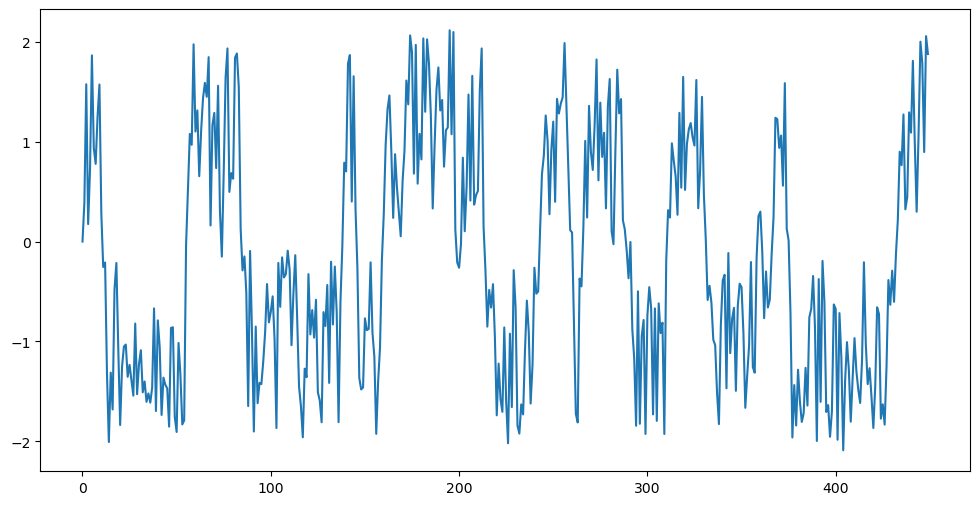
This dataset is generated as where . The function is plotted below.
def g(x):
return 2 * x / (1 + 0.8 * x**2)
x_vals = np.linspace(-2, 2, 400)
y_vals = g(x_vals)
# Plot the function
plt.figure(figsize = (12, 6))
plt.plot(x_vals, y_vals)
plt.title(r'$g(x) = \frac{2x}{1 + 0.8x^2}$')
plt.xlabel('x')
plt.ylabel('g(x)')
plt.grid(True)
plt.show()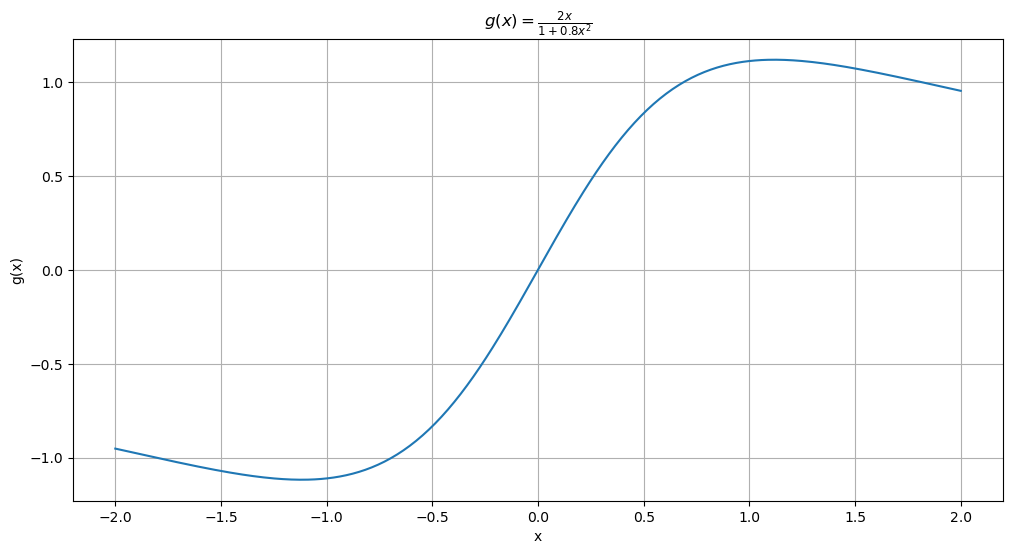
We will fit the model (below )
This model is represented by the following class.
class PiecewiseLinearModel(nn.Module):
def __init__(self, knots_init, beta_init):
super().__init__()
self.num_knots = len(knots_init)
self.beta = nn.Parameter(torch.tensor(beta_init, dtype=torch.float32))
self.knots = nn.Parameter(torch.tensor(knots_init, dtype=torch.float32))
def forward(self, x):
knots_sorted, _ = torch.sort(self.knots)
out = self.beta[0] + self.beta[1] * x
for j in range(self.num_knots):
out += self.beta[j + 2] * torch.relu(x - knots_sorted[j])
return outWe create tensors for and below.
y_reg = y_sim[1:]
x_reg = y_sim[0:(n-1)]
y_torch = torch.tensor(y_reg, dtype = torch.float32).unsqueeze(1)
x_torch = torch.tensor(x_reg, dtype = torch.float32).unsqueeze(1)Below we find initial values for and .
k = 6
quantile_levels = np.linspace(1/(k+1), k/(k+1), k)
knots_init = np.quantile(x_reg, quantile_levels)
n_reg = len(y_reg)
X = np.column_stack([np.ones(n_reg), x_reg])
for j in range(k):
xc = ((x_reg > knots_init[j]).astype(float))*(x_reg - knots_init[j])
X = np.column_stack([X, xc])
md_init = sm.OLS(y_reg, X).fit()
beta_init = md_init.params
print(knots_init)
print(beta_init)[-1.54280223 -1.02805822 -0.60360061 -0.09440788 0.61283012 1.2719812 ]
[-2.31279716 -0.66056549 0.83205759 0.42017211 0.77300214 0.83540066
-2.59891684 0.37725608]
Below we fit the model and estimate parameters.
nar = PiecewiseLinearModel(knots_init = knots_init, beta_init = beta_init)optimizer = optim.Adam(nar.parameters(), lr = 0.01)
loss_fn = nn.MSELoss()
for epoch in range(10000):
optimizer.zero_grad()
y_pred = nar(x_torch)
loss = loss_fn(y_pred, y_torch)
loss.backward()
optimizer.step()
if epoch % 100 == 0:
print(f"Epoch {epoch}, Loss: {loss.item():.4f}")
#Run this code a few times to be sure of convergence. Epoch 0, Loss: 0.3186
Epoch 100, Loss: 0.3166
Epoch 200, Loss: 0.3163
Epoch 300, Loss: 0.3162
Epoch 400, Loss: 0.3161
Epoch 500, Loss: 0.3161
Epoch 600, Loss: 0.3161
Epoch 700, Loss: 0.3161
Epoch 800, Loss: 0.3161
Epoch 900, Loss: 0.3161
Epoch 1000, Loss: 0.3161
Epoch 1100, Loss: 0.3161
Epoch 1200, Loss: 0.3161
Epoch 1300, Loss: 0.3161
Epoch 1400, Loss: 0.3161
Epoch 1500, Loss: 0.3161
Epoch 1600, Loss: 0.3161
Epoch 1700, Loss: 0.3161
Epoch 1800, Loss: 0.3161
Epoch 1900, Loss: 0.3161
Epoch 2000, Loss: 0.3161
Epoch 2100, Loss: 0.3161
Epoch 2200, Loss: 0.3161
Epoch 2300, Loss: 0.3161
Epoch 2400, Loss: 0.3161
Epoch 2500, Loss: 0.3161
Epoch 2600, Loss: 0.3161
Epoch 2700, Loss: 0.3161
Epoch 2800, Loss: 0.3161
Epoch 2900, Loss: 0.3161
Epoch 3000, Loss: 0.3161
Epoch 3100, Loss: 0.3161
Epoch 3200, Loss: 0.3161
Epoch 3300, Loss: 0.3161
Epoch 3400, Loss: 0.3161
Epoch 3500, Loss: 0.3161
Epoch 3600, Loss: 0.3161
Epoch 3700, Loss: 0.3161
Epoch 3800, Loss: 0.3161
Epoch 3900, Loss: 0.3161
Epoch 4000, Loss: 0.3161
Epoch 4100, Loss: 0.3161
Epoch 4200, Loss: 0.3161
Epoch 4300, Loss: 0.3161
Epoch 4400, Loss: 0.3161
Epoch 4500, Loss: 0.3161
Epoch 4600, Loss: 0.3161
Epoch 4700, Loss: 0.3161
Epoch 4800, Loss: 0.3161
Epoch 4900, Loss: 0.3161
Epoch 5000, Loss: 0.3161
Epoch 5100, Loss: 0.3161
Epoch 5200, Loss: 0.3161
Epoch 5300, Loss: 0.3161
Epoch 5400, Loss: 0.3161
Epoch 5500, Loss: 0.3161
Epoch 5600, Loss: 0.3161
Epoch 5700, Loss: 0.3161
Epoch 5800, Loss: 0.3161
Epoch 5900, Loss: 0.3161
Epoch 6000, Loss: 0.3161
Epoch 6100, Loss: 0.3161
Epoch 6200, Loss: 0.3161
Epoch 6300, Loss: 0.3161
Epoch 6400, Loss: 0.3161
Epoch 6500, Loss: 0.3161
Epoch 6600, Loss: 0.3161
Epoch 6700, Loss: 0.3161
Epoch 6800, Loss: 0.3161
Epoch 6900, Loss: 0.3161
Epoch 7000, Loss: 0.3161
Epoch 7100, Loss: 0.3161
Epoch 7200, Loss: 0.3161
Epoch 7300, Loss: 0.3161
Epoch 7400, Loss: 0.3161
Epoch 7500, Loss: 0.3161
Epoch 7600, Loss: 0.3161
Epoch 7700, Loss: 0.3161
Epoch 7800, Loss: 0.3161
Epoch 7900, Loss: 0.3161
Epoch 8000, Loss: 0.3161
Epoch 8100, Loss: 0.3161
Epoch 8200, Loss: 0.3161
Epoch 8300, Loss: 0.3161
Epoch 8400, Loss: 0.3161
Epoch 8500, Loss: 0.3161
Epoch 8600, Loss: 0.3161
Epoch 8700, Loss: 0.3161
Epoch 8800, Loss: 0.3161
Epoch 8900, Loss: 0.3161
Epoch 9000, Loss: 0.3161
Epoch 9100, Loss: 0.3161
Epoch 9200, Loss: 0.3161
Epoch 9300, Loss: 0.3161
Epoch 9400, Loss: 0.3161
Epoch 9500, Loss: 0.3161
Epoch 9600, Loss: 0.3161
Epoch 9700, Loss: 0.3161
Epoch 9800, Loss: 0.3161
Epoch 9900, Loss: 0.3161
Below we plot the function and the estimated function .
x_vals_torch = torch.tensor(x_vals, dtype = torch.float32).unsqueeze(1)
ghat_nar = nar(x_vals_torch).detach().numpy()
# Plot the function
plt.figure(figsize = (12, 6))
plt.plot(x_vals, y_vals, label = 'True function g')
plt.plot(x_vals, ghat_nar, color = 'red', label = 'Fitted function by the Nonlinear AR model')
plt.title(r'$g(x) = \frac{2x}{1 + 0.8x^2}$')
plt.xlabel('x')
plt.ylabel('g(x)')
plt.grid(True)
plt.show()
We can also superimpose the fitted linear function by the usual AR(1) model.
#Function fitted by AR(1)
ar = AutoReg(y_sim, lags = 1).fit()
print(ar.params)
ar_vals = ar.params[0] + ar.params[1] * x_vals
# Plot the function
plt.figure(figsize = (12, 6))
plt.plot(x_vals, y_vals, label = 'True function g')
plt.plot(x_vals, ghat_nar, color = 'red', label = 'Fitted function by the Nonlinear AR model')
plt.plot(x_vals, ar_vals, color = 'green', label = 'Fitted function by the AR(1) model')
plt.title(r'$g(x) = \frac{2x}{1 + 0.8x^2}$')
plt.xlabel('x')
plt.ylabel('g(x)')
plt.grid(True)
plt.show()[-0.03280141 0.81247368]
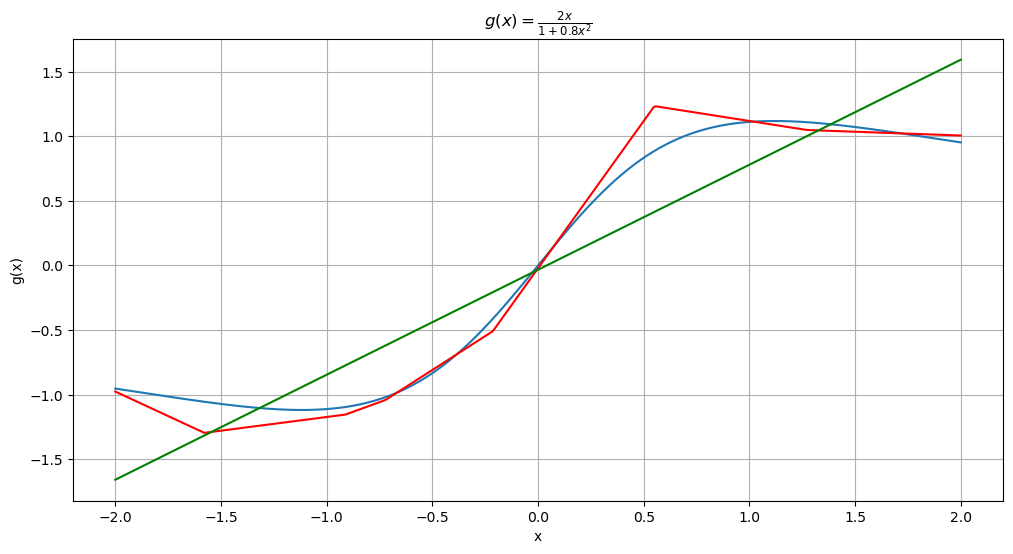
We plot these fitted functions on the data .
plt.figure(figsize = (12, 6))
plt.scatter(y_sim[:-1], y_sim[1:], s = 5)
plt.plot(x_vals, y_vals, label = 'True function g')
plt.plot(x_vals, ghat_nar, color = 'red', label = 'Fitted function by the Nonlinear AR model')
plt.plot(x_vals, ar_vals, color = 'green', label = 'Fitted function by the AR(1) model')
plt.xlabel('y[t-1]')
plt.ylabel('y[t]')
plt.show()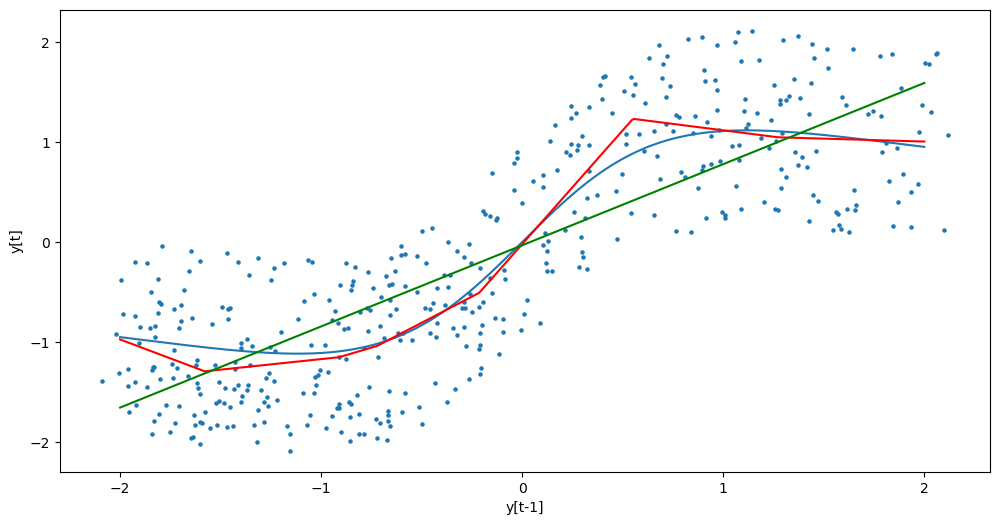
Now we obtain predictions for future observations. We obtain predictions with the fitted nonlinear AR(1) model as well as the model where we use the true function.
#Predictions:
#with fitted model
last_val = torch.tensor([[y_sim[-1]]], dtype = torch.float32)
future_preds = []
k_future = 100
for _ in range(k_future):
next_val = nar(last_val)
future_preds.append(next_val.item())
last_val = next_val.detach()
future_preds_array = np.array(future_preds)
#with actual g
actual_preds = []
for _ in range(k_future):
next_val = ((2*last_val)/(1 + 0.8 * (last_val ** 2)))
actual_preds.append(next_val.item())
last_val = next_val.detach()
actual_preds_array = np.array(actual_preds)
n_y = len(y_sim)
tme = range(1, n_y+1)
tme_future = range(n_y+1, n_y+k_future+1)
fcast = ar.get_prediction(start = n_y, end = n_y+k_future-1).predicted_mean
plt.figure(figsize = (12, 7))
plt.plot(tme, y_sim, label = 'Data')
plt.plot(tme_future, fcast, label = 'Forecast (AR(1))', color = 'green')
plt.plot(tme_future, future_preds_array, label = 'Forecast - NAR', color = 'red')
plt.plot(tme_future, actual_preds_array, label = 'Forecast - True NAR', color = 'black')
plt.axvline(x=n_y, color='gray', linestyle='--')
plt.legend()
plt.show()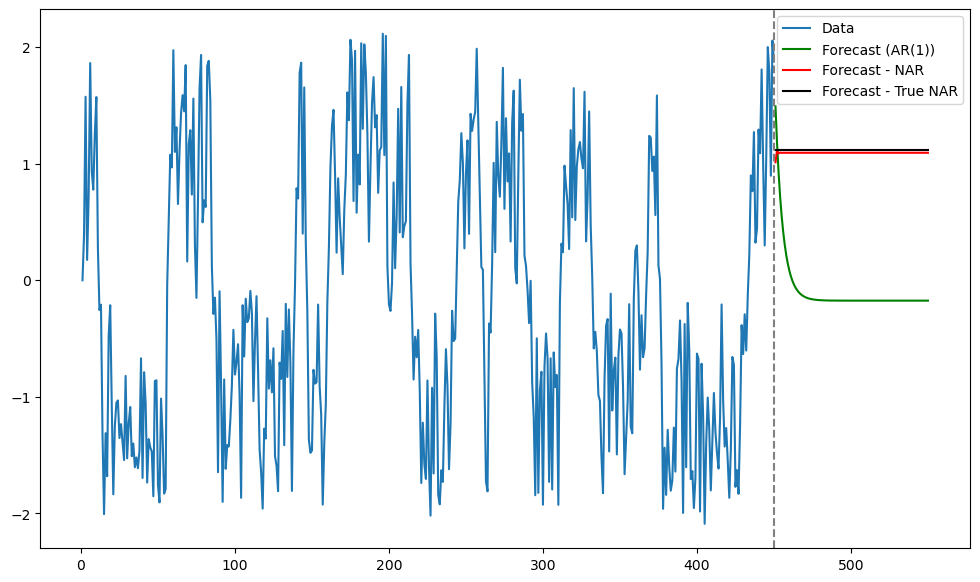
It is clear that the predictions obtained by the NAR(1) model are very close to those obtained by using the true function. Also these predictions are quite different from the predictions of the linear AR(1) model.
Example Two¶
Below we change the data generation model to:
In other words, is replaced by .
n = 1450
rng = np.random.default_rng(seed = 40)
eps = rng.uniform(low = -1.0, high = 1.0, size = n)
truelag = 5
y_sim = np.full(n, 0, dtype = float)
y_sim[:(truelag - 1)] = rng.uniform(low = -1, high = 1, size = truelag - 1)
for i in range(truelag, n):
y_sim[i] = ((2*y_sim[i-truelag])/(1 + 0.8 * (y_sim[i-truelag] ** 2))) + eps[i]
plt.figure(figsize = (12, 6))
plt.plot(y_sim)
plt.show()
We will use the single hidden layer neural network model with for this data.
class SingleHiddenLayerNN(nn.Module):
def __init__(self, input_dim, hidden_dim):
super().__init__()
self.W = nn.Linear(input_dim, hidden_dim)
self.beta = nn.Linear(hidden_dim, 1)
def forward(self, x):
s = self.W(x)
#r = torch.sigmoid(s)
r = torch.relu(s)
#r = torch.tanh(s)
mu = self.beta(r)
return mu.squeeze()torch.manual_seed(3)
#Create x's and y's from the data (x is simply the lagged values). Also conversion to tensors.
p = truelag
y = torch.tensor(y_sim, dtype = torch.float32)
n = len(y)
x_list = []
y_list = []
for t in range(p, n):
x_list.append(y[t-p : t]) #(y_{t-1}, \dots, y_{t-p})
y_list.append(y[t]) #y_t
x_data = torch.stack(x_list) #shape: (n-p, p)
y_data = torch.stack(y_list) #shape: (n-p,)The model is fit in the following way.
k = 6
nar_model = SingleHiddenLayerNN(input_dim=p, hidden_dim=k)
loss_fn = nn.MSELoss()
optimizer = optim.Adam(nar_model.parameters(), lr = 0.01)
num_epochs = 10000
for epoch in range(num_epochs):
optimizer.zero_grad()
mu_pred = nar_model(x_data)
loss = loss_fn(mu_pred, y_data)
loss.backward()
optimizer.step()
if epoch % 200 == 0:
print(f"Epoch {epoch}, Loss: {loss.item(): .6f}")Epoch 0, Loss: 0.957468
Epoch 200, Loss: 0.416492
Epoch 400, Loss: 0.389080
Epoch 600, Loss: 0.338375
Epoch 800, Loss: 0.337272
Epoch 1000, Loss: 0.336349
Epoch 1200, Loss: 0.335065
Epoch 1400, Loss: 0.334118
Epoch 1600, Loss: 0.332721
Epoch 1800, Loss: 0.332244
Epoch 2000, Loss: 0.331803
Epoch 2200, Loss: 0.331380
Epoch 2400, Loss: 0.331162
Epoch 2600, Loss: 0.331000
Epoch 2800, Loss: 0.330908
Epoch 3000, Loss: 0.330862
Epoch 3200, Loss: 0.330896
Epoch 3400, Loss: 0.330697
Epoch 3600, Loss: 0.330606
Epoch 3800, Loss: 0.330560
Epoch 4000, Loss: 0.330592
Epoch 4200, Loss: 0.330519
Epoch 4400, Loss: 0.330571
Epoch 4600, Loss: 0.330325
Epoch 4800, Loss: 0.330287
Epoch 5000, Loss: 0.330349
Epoch 5200, Loss: 0.330291
Epoch 5400, Loss: 0.330297
Epoch 5600, Loss: 0.330337
Epoch 5800, Loss: 0.330293
Epoch 6000, Loss: 0.330287
Epoch 6200, Loss: 0.330297
Epoch 6400, Loss: 0.330288
Epoch 6600, Loss: 0.330314
Epoch 6800, Loss: 0.330307
Epoch 7000, Loss: 0.330318
Epoch 7200, Loss: 0.330294
Epoch 7400, Loss: 0.330281
Epoch 7600, Loss: 0.330333
Epoch 7800, Loss: 0.330292
Epoch 8000, Loss: 0.330287
Epoch 8200, Loss: 0.330287
Epoch 8400, Loss: 0.330287
Epoch 8600, Loss: 0.330288
Epoch 8800, Loss: 0.330465
Epoch 9000, Loss: 0.330285
Epoch 9200, Loss: 0.330288
Epoch 9400, Loss: 0.330291
Epoch 9600, Loss: 0.330399
Epoch 9800, Loss: 0.330337
Next we obtain predictions.
#Predictions
nar_model.eval()
predictions = []
k_future = 40
current_input = y[-p:]
for i in range(k_future):
with torch.no_grad():
mu = nar_model(current_input.unsqueeze(0))
predictions.append(mu.item())
current_input = torch.cat([current_input[1:], mu.unsqueeze(0)])
predictions = np.array(predictions)
current_input = y[-p:]
print(y)
print(current_input)
print(current_input[0])
print(current_input[0].detach().numpy())tensor([-0.6649, -0.9638, 0.0533, ..., -0.1717, 1.1205, -1.6019])
tensor([-1.6860, -0.2503, -0.1717, 1.1205, -1.6019])
tensor(-1.6860)
-1.6860132
For comparison, here are the predictions with the true .
#Actual predictions using the true function:
actual_predictions = []
current_input = y[-p:]
for i in range(k_future):
lastval = current_input[0]
next_val = ((2*lastval)/(1 + 0.8 * (lastval ** 2)))
actual_predictions.append(next_val)
current_input = np.concatenate([current_input[1:], np.array([next_val])])
actual_predictions = np.array(actual_predictions)
Again for comparison, here are the predictions by the linear AR() model with .
ar = AutoReg(y_sim, lags = p).fit()
n_y = len(y_sim)
tme = range(1, n_y+1)
tme_future = range(n_y+1, n_y+k_future+1)
fcast = ar.get_prediction(start = n_y, end = n_y+k_future-1).predicted_meanBelow are the predictions by the three models (along with the observed data).
n_y = len(y_sim)
tme = range(1, n_y+1)
tme_future = range(n_y+1, n_y+k_future+1)
plt.figure(figsize = (12, 7))
plt.plot(tme, y_sim, label = 'Data')
plt.plot(tme_future, fcast, label = 'Forecast (AR(p))', color = 'green')
plt.plot(tme_future, predictions, label = 'Forecast - NAR', color = 'red')
plt.plot(tme_future, actual_predictions, label = 'Forecast - True NAR', color = 'black')
plt.axvline(x=n_y, color='gray', linestyle='--')
plt.legend()
plt.show()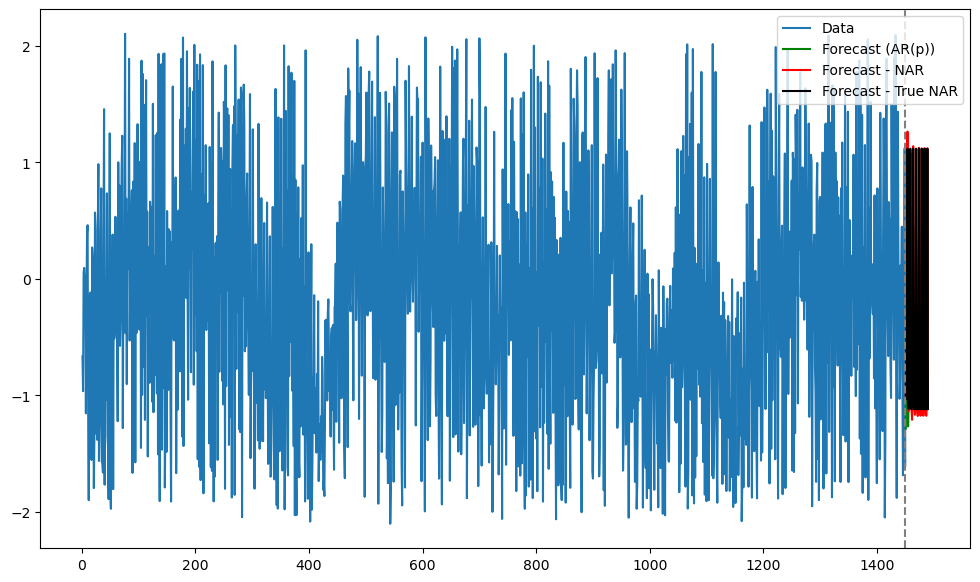
For better visualization, let us only plot the predictions obtained by the three models.
n_y = len(y_sim)
tme = range(1, n_y+1)
tme_future = range(n_y+1, n_y+k_future+1)
plt.figure(figsize = (12, 7))
plt.plot(tme_future, fcast, label = 'Forecast (AR(p))', color = 'green')
plt.plot(tme_future, predictions, label = 'Forecast - NAR', color = 'red')
plt.plot(tme_future, actual_predictions, label = 'Forecast - True NAR', color = 'black')
#plt.axvline(x=n_y, color='gray', linestyle='--')
plt.legend()
plt.show()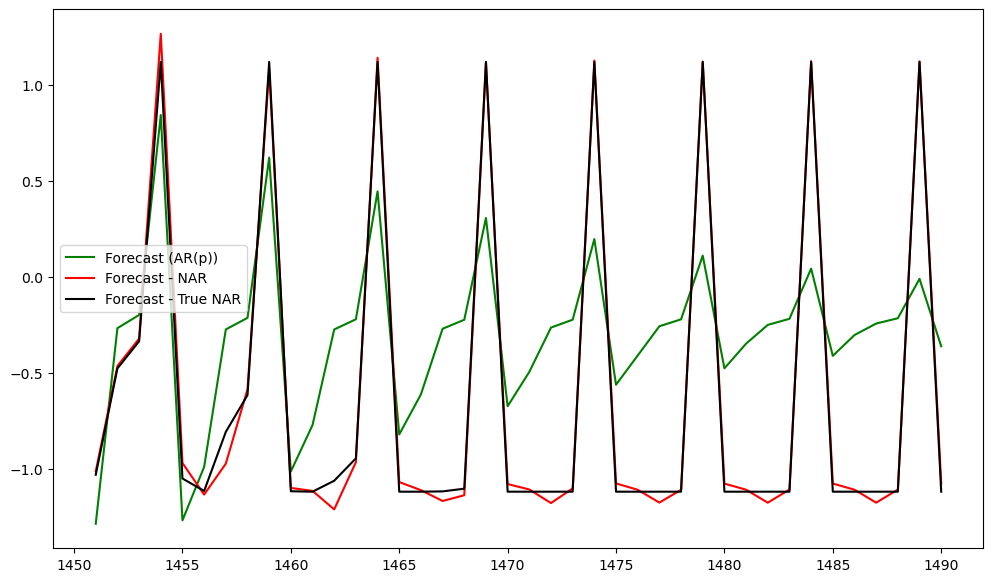
The closeness of predictions by the NAR() model and AR() model compared with the predictions obtained from the true value of are computed by the MSEs below.
mse_ar = np.mean( (actual_predictions - fcast) ** 2)
mse_NAR = np.mean( (actual_predictions - predictions) ** 2)
print(mse_ar, mse_NAR, mse_ar/mse_NAR)0.49578311371259687 0.0027808830340550596 178.28262017538012
Below we plot the data along with the actual function , and the fitted values by the NAR() model.
nar_fits = nar_model(x_data)
print(x_data[:,0].shape)
print(nar_fits.shape)
# Sort x_data[:,0] and corresponding nar_fits
sorted_indices = torch.argsort(x_data[:,0])
x_sorted = x_data[:,0][sorted_indices]
nar_fits_sorted = nar_fits[sorted_indices]
def g(x):
return 2 * x / (1 + 0.8 * x**2)
true_g_vals = g(x_sorted.detach().numpy())
plt.figure(figsize=(12, 6))
plt.plot(x_sorted.detach().numpy(), nar_fits_sorted.detach().numpy(), label = 'Fitted values')
plt.plot(x_sorted.detach().numpy(), true_g_vals, color = 'red', label = 'Actual g values')
plt.title('Plotting fitted values against y_{t-5}')
plt.xlabel('y_{t-5}')
plt.ylabel('Fitted values')
plt.show()
torch.Size([1445])
torch.Size([1445])
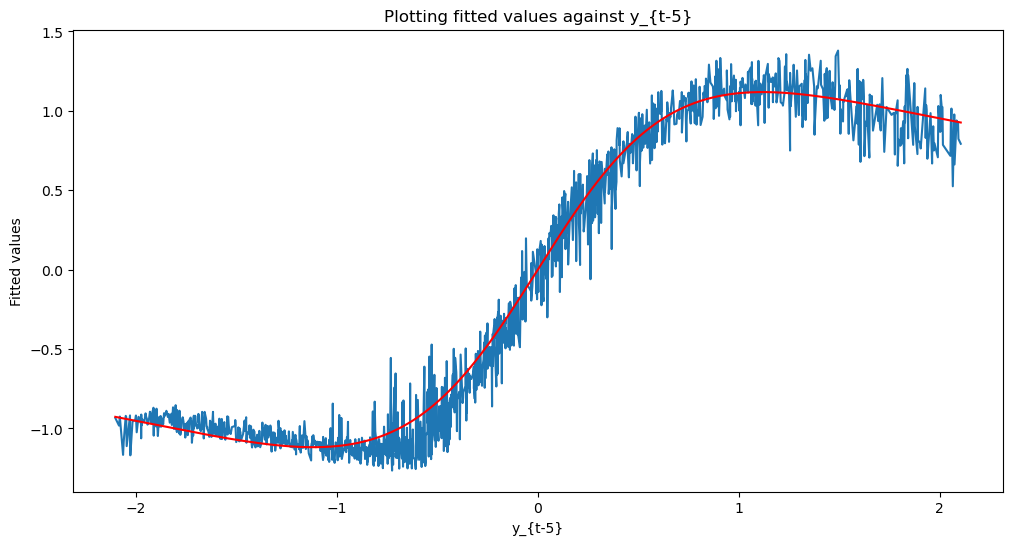
Example Three¶
Now we repeat the exercise but we now change to . We also fit NAR() and AR() models with . Now NAR() becomes a model with many parameters so there will be the issue of overfitting.
n = 1450
rng = np.random.default_rng(seed = 40)
eps = rng.uniform(low = -1.0, high = 1.0, size = n)
truelag = 20
y_sim = np.full(n, 0, dtype = float)
y_sim[:(truelag - 1)] = rng.uniform(low = -1, high = 1, size = truelag - 1)
for i in range(truelag, n):
y_sim[i] = ((2*y_sim[i-truelag])/(1 + 0.8 * (y_sim[i-truelag] ** 2))) + eps[i]
plt.figure(figsize = (12, 6))
plt.plot(y_sim)
plt.show()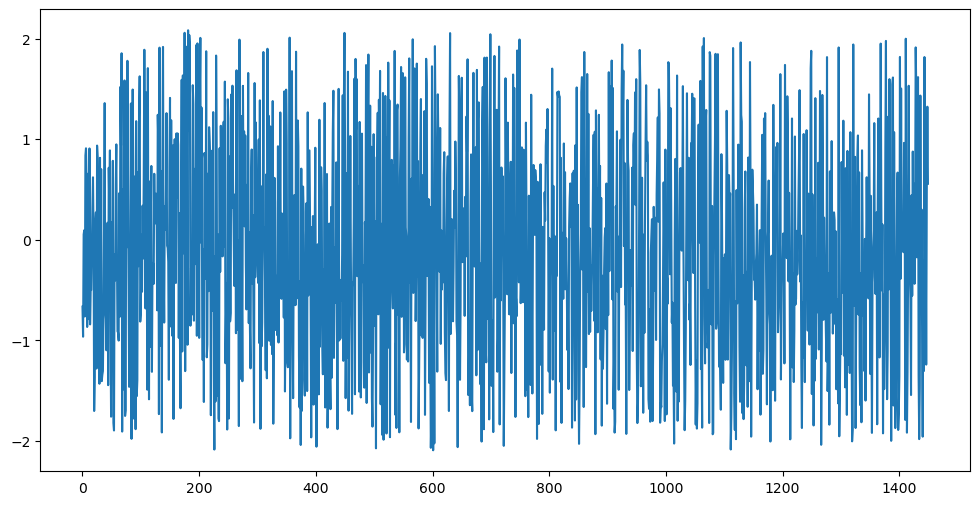
class SingleHiddenLayerNN(nn.Module):
def __init__(self, input_dim, hidden_dim):
super().__init__()
self.W = nn.Linear(input_dim, hidden_dim)
self.beta = nn.Linear(hidden_dim, 1)
def forward(self, x):
s = self.W(x)
#r = torch.sigmoid(s)
r = torch.relu(s)
#r = torch.tanh(s)
mu = self.beta(r)
return mu.squeeze()torch.manual_seed(3)
#Create x's and y's from the data (x is simply the lagged values). Also conversion to tensors.
p = truelag
y = torch.tensor(y_sim, dtype = torch.float32)
n = len(y)
x_list = []
y_list = []
for t in range(p, n):
x_list.append(y[t-p : t]) #(y_{t-1}, \dots, y_{t-p})
y_list.append(y[t]) #y_t
x_data = torch.stack(x_list) #shape: (n-p, p)
y_data = torch.stack(y_list) #shape: (n-p,)k = 6
nar_model = SingleHiddenLayerNN(input_dim=p, hidden_dim=k)
loss_fn = nn.MSELoss()
optimizer = optim.Adam(nar_model.parameters(), lr = 0.01)
num_epochs = 10000
for epoch in range(num_epochs):
optimizer.zero_grad()
mu_pred = nar_model(x_data)
loss = loss_fn(mu_pred, y_data)
loss.backward()
optimizer.step()
if epoch % 200 == 0:
print(f"Epoch {epoch}, Loss: {loss.item(): .6f}")Epoch 0, Loss: 1.454649
Epoch 200, Loss: 0.379441
Epoch 400, Loss: 0.373239
Epoch 600, Loss: 0.368197
Epoch 800, Loss: 0.367407
Epoch 1000, Loss: 0.367285
Epoch 1200, Loss: 0.367280
Epoch 1400, Loss: 0.367292
Epoch 1600, Loss: 0.367298
Epoch 1800, Loss: 0.367281
Epoch 2000, Loss: 0.367306
Epoch 2200, Loss: 0.367287
Epoch 2400, Loss: 0.367290
Epoch 2600, Loss: 0.367310
Epoch 2800, Loss: 0.367283
Epoch 3000, Loss: 0.367293
Epoch 3200, Loss: 0.367269
Epoch 3400, Loss: 0.367162
Epoch 3600, Loss: 0.367093
Epoch 3800, Loss: 0.364829
Epoch 4000, Loss: 0.364723
Epoch 4200, Loss: 0.364730
Epoch 4400, Loss: 0.364724
Epoch 4600, Loss: 0.364736
Epoch 4800, Loss: 0.364697
Epoch 5000, Loss: 0.364703
Epoch 5200, Loss: 0.364687
Epoch 5400, Loss: 0.364697
Epoch 5600, Loss: 0.364705
Epoch 5800, Loss: 0.364676
Epoch 6000, Loss: 0.364709
Epoch 6200, Loss: 0.364662
Epoch 6400, Loss: 0.364705
Epoch 6600, Loss: 0.364678
Epoch 6800, Loss: 0.364711
Epoch 7000, Loss: 0.364670
Epoch 7200, Loss: 0.364697
Epoch 7400, Loss: 0.364688
Epoch 7600, Loss: 0.364677
Epoch 7800, Loss: 0.364706
Epoch 8000, Loss: 0.364733
Epoch 8200, Loss: 0.364688
Epoch 8400, Loss: 0.364683
Epoch 8600, Loss: 0.364677
Epoch 8800, Loss: 0.364666
Epoch 9000, Loss: 0.364684
Epoch 9200, Loss: 0.364684
Epoch 9400, Loss: 0.364706
Epoch 9600, Loss: 0.364668
Epoch 9800, Loss: 0.364667
#Predictions
nar_model.eval()
predictions = []
k_future = 40
current_input = y[-p:]
for i in range(k_future):
with torch.no_grad():
mu = nar_model(current_input.unsqueeze(0))
predictions.append(mu.item())
current_input = torch.cat([current_input[1:], mu.unsqueeze(0)])
predictions = np.array(predictions)
current_input = y[-p:]
print(y)
print(current_input)
print(current_input[0])
print(current_input[0].detach().numpy())tensor([-0.6649, -0.9638, 0.0533, ..., 0.4710, 1.3228, 0.5566])
tensor([-0.1745, 1.3297, 1.6169, -1.3475, -1.9818, -1.4642, 1.4335, -0.4679,
0.3011, -0.9683, -1.9576, -0.2013, -1.3051, 1.8167, -0.1115, 0.2793,
-1.2411, 0.4710, 1.3228, 0.5566])
tensor(-0.1745)
-0.17447984
#Actual predictions using the true function:
actual_predictions = []
current_input = y[-p:]
for i in range(k_future):
lastval = current_input[0]
next_val = ((2*lastval)/(1 + 0.8 * (lastval ** 2)))
actual_predictions.append(next_val)
current_input = np.concatenate([current_input[1:], np.array([next_val])])
actual_predictions = np.array(actual_predictions)
ar = AutoReg(y_sim, lags = p).fit()
n_y = len(y_sim)
tme = range(1, n_y+1)
tme_future = range(n_y+1, n_y+k_future+1)
fcast = ar.get_prediction(start = n_y, end = n_y+k_future-1).predicted_meann_y = len(y_sim)
tme = range(1, n_y+1)
tme_future = range(n_y+1, n_y+k_future+1)
plt.figure(figsize = (12, 7))
plt.plot(tme, y_sim, label = 'Data')
plt.plot(tme_future, fcast, label = 'Forecast (AR(1))', color = 'green')
plt.plot(tme_future, predictions, label = 'Forecast - NAR', color = 'red')
plt.plot(tme_future, actual_predictions, label = 'Forecast - True NAR', color = 'black')
plt.axvline(x=n_y, color='gray', linestyle='--')
plt.legend()
plt.show()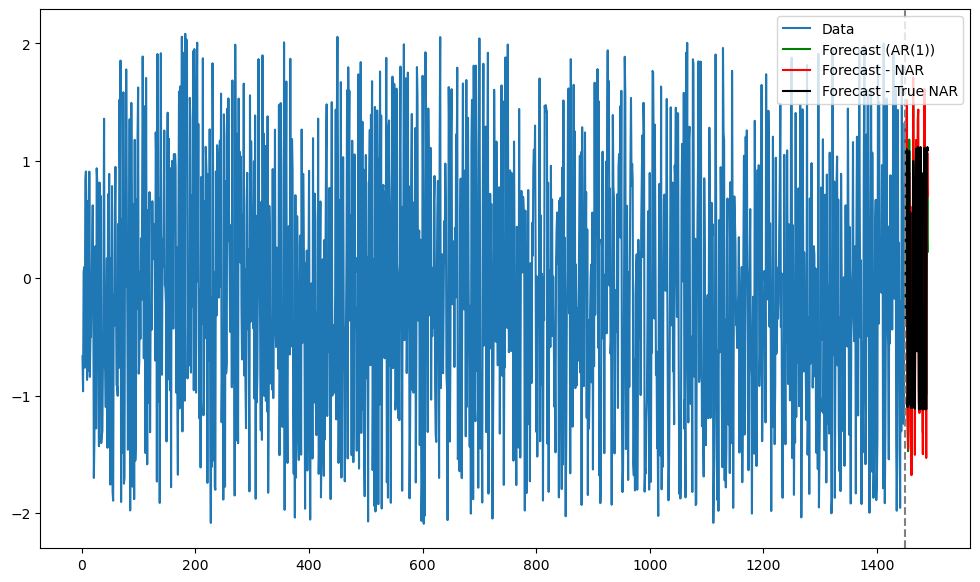
n_y = len(y_sim)
tme = range(1, n_y+1)
tme_future = range(n_y+1, n_y+k_future+1)
plt.figure(figsize = (12, 7))
plt.plot(tme_future, fcast, label = 'Forecast (AR(p))', color = 'green')
plt.plot(tme_future, predictions, label = 'Forecast - NAR', color = 'red')
plt.plot(tme_future, actual_predictions, label = 'Forecast - True NAR', color = 'black')
#plt.axvline(x=n_y, color='gray', linestyle='--')
plt.legend()
plt.show()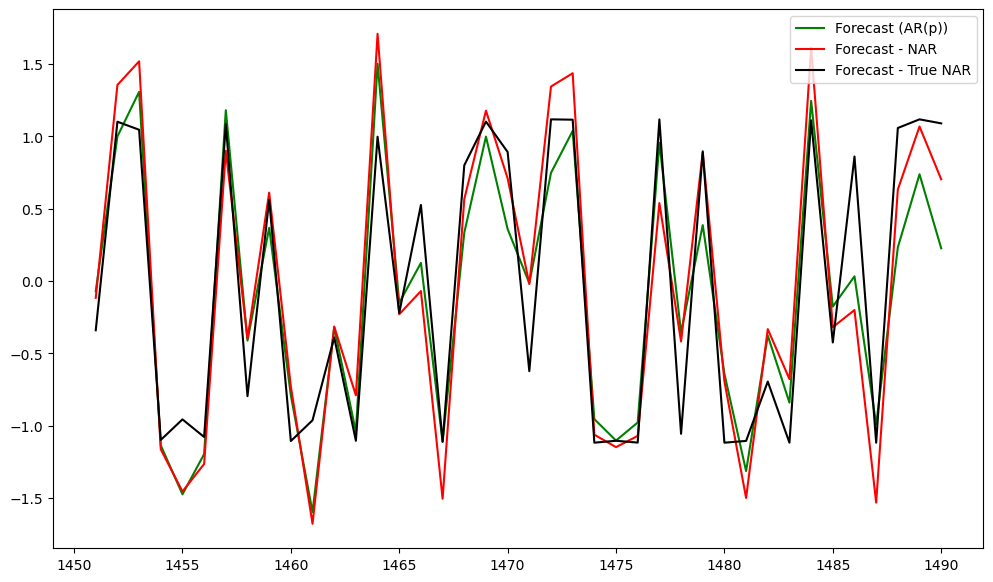
The predictions by NAR() model are not as close to the true predictions (i.e., obtained using the true function ) as in the previous case when is small. In fact now, the predictions for the linear AR() model seem closer to the true predictions. This is a result of overfitting.
mse_ar = np.mean( (actual_predictions - fcast) ** 2)
mse_NAR = np.mean( (actual_predictions - predictions) ** 2)
print(mse_ar, mse_NAR, mse_ar/mse_NAR)0.15533280348971384 0.1627774080292371 0.9542651241984017
nar_fits = nar_model(x_data)
print(x_data[:,0].shape)
print(nar_fits.shape)
# Sort x_data[:,0] and corresponding nar_fits
sorted_indices = torch.argsort(x_data[:,0])
x_sorted = x_data[:,0][sorted_indices]
nar_fits_sorted = nar_fits[sorted_indices]
def g(x):
return 2 * x / (1 + 0.8 * x**2)
true_g_vals = g(x_sorted.detach().numpy())
plt.figure(figsize=(12, 6))
plt.plot(x_sorted.detach().numpy(), nar_fits_sorted.detach().numpy(), label = 'Fitted values')
plt.plot(x_sorted.detach().numpy(), true_g_vals, color = 'red', label = 'Actual g values')
plt.title('Plotting fitted values against y_{t-p}')
plt.xlabel('y_{t-p}')
plt.ylabel('Fitted values')
plt.show()
torch.Size([1430])
torch.Size([1430])
